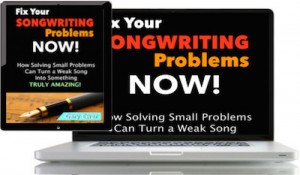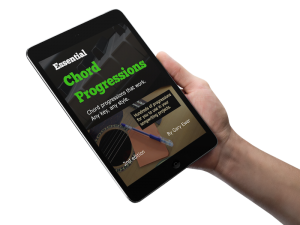A common stumbling block for songwriters is: how to continue a song once that initial song idea has been created. It can feel very discouraging, because often that first song idea happens easily, and you feel excited for what’s to come. And then… nothing.
I wrote about this a week or so ago, and in that post I was suggesting the psychological power that comes from imagining that your song is actually already finished. When you do that, new ideas about how the song should proceed will sometimes pop into your head.
 Fix Your Songwriting Problems – NOW! shows you the most common songwriting problems that you’ll encounter as a new songwriter, and then offers solutions you can try. Keep the songwriting process moving forward!
Fix Your Songwriting Problems – NOW! shows you the most common songwriting problems that you’ll encounter as a new songwriter, and then offers solutions you can try. Keep the songwriting process moving forward!
But there may be something else at play here that can be preventing you from expanding on that initial musical idea: you’ve misplaced that musical fragment, trying to make it work, for example, as a chorus hook, when in fact it might be a better verse.
Here’s more about what I mean. Songs are made up of several different sections. The most common of these are verses and choruses, but many songs have other optional sections: intro, pre-chorus, bridge, instrumental solos, and more.
Most of these sections use different melodies and chords. But there’s another main difference: they all exhibit a different level of musical energy. Here’s a typical description of some of the more common sections:
- VERSE: Low musical energy, often building toward the chorus.
- PRE-CHORUS: Low-to-high musical energy.
- CHORUS: High musical energy.
- BRIDGE: Either low musical energy (to contrast with the more energetic chorus), or high-to-even-higher musical energy to set things up for the final chorus repeats.
The level of musical energy is usually determined by, among other things:
- The range of the melody;
- Vocal quality of the lead singer;
- Instrumental sound.
So when you compose that first musical idea, your first job is really to plan out where the idea belongs.
And the snag in the process could come from spending a lot of time trying to figure out why your chorus hook isn’t working, when in fact it may be as simple as realizing that it isn’t really exhibiting the qualities of a good chorus hook. It may, in fact, be a better verse idea.
So if you find that your songwriting process is always grinding to a halt after you’ve written a good, short musical fragment, give the following some thought:
- Assess your idea. Listen to your musical fragment and be sure you’ve actually written something you like. This is often best done the day after, once the excitement for having written something subsides. From that more distant position, do you still like it?
- Look at the melodic range. Is it generally high in pitch? Low? Does it move from low to high? (Could be a good verse). High to low? (Could be good for a verse-only song).
- Transpose your idea up or down. If you want your new idea to be a chorus hook, but it’s not really working, try moving it up a few keys to see if you can get it to have the energy it needs. If you thought it would be a good idea for a verse, you may need to move it down to a range that keeps musical energy from building too quickly.
- Work out some instrumental ideas that help your idea live comfortably in the section you’ve chosen for it.
- It’s not a failure if you put it away. Keep in mind that some great songs have been made by pulling together bits of music that didn’t seem to have a way forward. “A Day In the Life” (Lennon & McCartney) is probably the most famous example. If you make a plan to occasionally take these little bits out and have another look, you may eventually find a partner section that gives it the life you were looking for.
 Written by Gary Ewer. Follow Gary on Twitter.
Written by Gary Ewer. Follow Gary on Twitter.
 If all you need to get the songwriting process working is a good chord progression, “The Essential Secrets of Songwriting 10-eBook Bundle” includes several eBooks with long lists of progressions you can use as is, or modify for your own songs. Check out the bundle today!
If all you need to get the songwriting process working is a good chord progression, “The Essential Secrets of Songwriting 10-eBook Bundle” includes several eBooks with long lists of progressions you can use as is, or modify for your own songs. Check out the bundle today!










